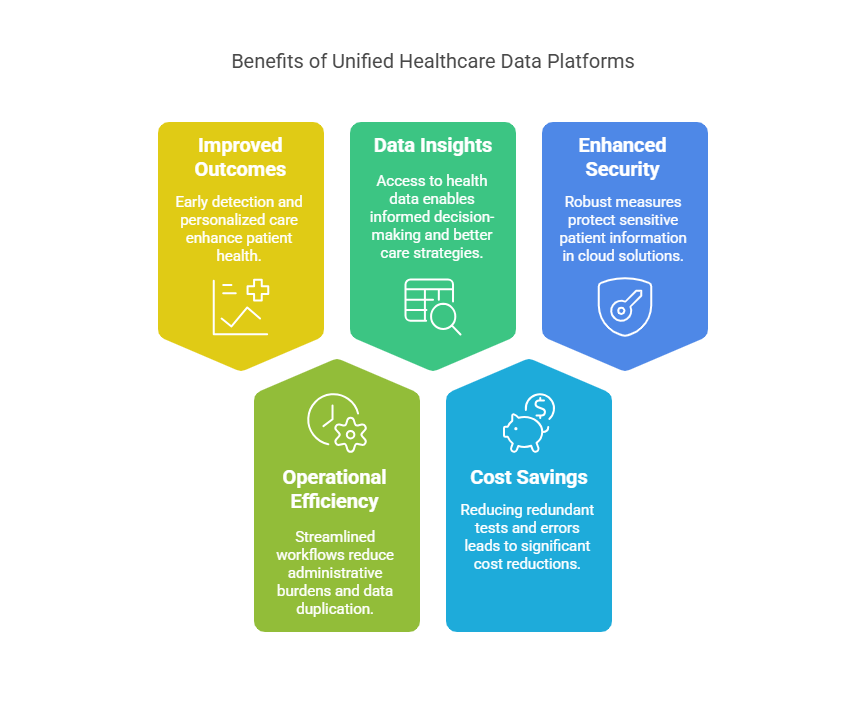Table of Contents
ToggleThe healthcare industry has long faced challenges with fragmented and siloed data, leading to inefficiencies, delays, and miscommunication between care teams. But with the rapid advancement of digital technologies, the emergence of unified healthcare data platforms has been a game-changer. It ensures that patient information is seamlessly integrated across systems.
In a world where time and accuracy are critical, these platforms provide healthcare providers with a single, cohesive view of patient history. This helping improve patient care, reduce costs, and enhance operational efficiency.
In this blog, we will explore how unified healthcare data platforms are revolutionizing patient care and why they are considered the future of healthcare.
What Are Unified Healthcare Data Platforms?
Unified healthcare data platforms are cloud-based systems designed to aggregate and integrate diverse data sources, including electronic health records (EHR), imaging data, laboratory results, real-time health monitoring, and telehealth information. These systems enable healthcare organizations to centralize and standardize patient data, making it easily accessible and actionable for care teams.
The integration of technologies like cloud computing, AI, and machine learning is essential in these platforms. Cloud platforms suc h as AWS HealthLake and Microsoft Azure Health Data Services are key players in this transformation, providing scalable, secure, and interoperable solutions. By 2025, 75% of healthcare providers are expected to use cloud-based platforms for healthcare data management.
According to MarketsAndMarkets, the healthcare data platform market is expected to grow at a compound annual growth rate (CAGR) of 22.6%, reaching $120 billion by 2027.
How Unified Data Platforms Are Transforming Patient Care?
Unified healthcare data platforms are reshaping the way healthcare providers approach patient care by enabling faster, more accurate decision-making. Integrated data platforms in healthcare are associated with a 20-30% improvement in patient outcomes, as they enable faster and more accurate diagnoses. Let’s look at the key ways these platforms are transforming healthcare:
Personalized Treatment Plans
By centralizing patient data from multiple sources, unified platforms enable healthcare providers to leverage AI and predictive analytics to personalize treatment plans. With access to detailed historical and real-time health data, physicians can develop more tailored treatments that account for the individual’s unique health needs.
For example, AI-driven oncology platforms use genetic and health data to determine the most effective treatment for cancer patients, reducing the trial-and-error approach and improving outcomes.
Faster Diagnoses and Treatment Decisions
In urgent care settings, time is critical. Unified healthcare data platforms eliminate delays by providing real-time access to lab results, imaging data, and patient histories. For instance, a cardiologist can immediately access a patient’s diagnostic test results, EKG, and imaging data, making quicker and more informed decisions. Real-time alerts from integrated systems also notify physicians when a patient’s condition requires urgent attention, significantly speeding up response times.
Proactive and Preventive Care
Using data analytics, unified healthcare data platforms facilitate predictive healthcare, where risks are detected early. For example, AI models can analyze trends in vital signs and lifestyle factors to predict the onset of chronic conditions like diabetes, enabling early intervention and reducing hospital admissions.
In remote care, IoT-enabled devices can transmit data about a patient’s vitals directly to healthcare providers, allowing proactive management of chronic conditions such as hypertension and asthma.
Enhanced Collaboration Among Providers
Unified data platforms break down communication barriers between specialists, primary care physicians, and caregivers. This collaboration ensures that all parties involved in a patient’s care have access to the same accurate and up-to-date information.
For example, patients with complex conditions like cancer may require input from oncologists, surgeons, and radiologists. A unified data platform allows all these specialists to view the same diagnostic information, improving collaboration and minimizing errors.
Remote Patient Monitoring and Virtual Health
With the rise of telemedicine, unified healthcare data platforms are critical for integrating remote monitoring devices and virtual health consultations. Patients with chronic conditions can now have their vitals monitored from home, while healthcare providers receive real-time data to make timely decisions.
The remote patient monitoring market is expected to grow from $1.8 billion in 2020 to $9.7 billion by 2027, reflecting an increase in the use of telemedicine and IoT-enabled devices.
For example, patients with diabetes can use a glucose monitor connected to the platform, enabling healthcare teams to intervene immediately if glucose levels exceed or fall below safe thresholds.
The Importance of Unified Data Platforms in Future Healthcare Systems
As the healthcare industry evolves, patient expectations for quick and transparent care are growing. Unified healthcare data platforms support this shift by ensuring that patient data is accessible, accurate, and up-to-date.
These platforms also facilitate compliance with global healthcare standards, including the FHIR (Fast Healthcare Interoperability Resources) standard for health data exchange. Moreover, with the increasing volume of data generated by wearables, genetic testing, and telemedicine, unified platforms provide the scalability needed to handle this information while ensuring data integrity and security.
Benefits of Unified Healthcare Data Platforms

Unified healthcare data platforms offer numerous benefits to healthcare organizations, patients, and care teams alike:
- Improved Patient Outcomes: Early detection of diseases, personalized treatment plans, and proactive care all contribute to better health outcomes.
- Operational Efficiency: These platforms streamline workflows, reduce administrative burdens, and eliminate data duplication, making the entire system more efficient.
- Data-Driven Insights: With access to vast amounts of health data, healthcare providers can make more informed decisions and improve care strategies.
- Cost Savings: By reducing redundant tests, hospital readmissions, and medical errors, unified platforms help healthcare organizations reduce costs.
- Enhanced Security: With cloud-based solutions, healthcare providers can implement robust data security measures to protect sensitive patient information.
Healthcare organizations that effectively integrate data across systems see up to a 40% improvement in operational efficiency.
Key Trends in Unified Healthcare Data Platforms
As healthcare continues to innovate, the following trends are shaping the future of unified data platforms:
AI-Driven Insights and Predictive Analytics:
AI is playing a crucial role in transforming healthcare. By analyzing vast amounts of patient data, AI models can predict disease progression and recommend optimal treatment options. In oncology, AI is already being used to identify patterns in genetic data and assist with personalized treatment planning.
Cloud-Enabled Interoperability:
Cloud platforms such as AWS HealthLake and Microsoft Azure Health Data Services are facilitating the integration of data across disparate systems, enabling seamless collaboration between healthcare organizations and improving data accessibility.
Voice-Enabled and NLP Technologies:
Natural Language Processing (NLP) and voice recognition are revolutionizing data entry and retrieval. Providers can now use voice commands to update patient records or retrieve information from the system, streamlining administrative processes.
Genomics and Precision Medicine:
Unified healthcare data platforms enable better integration of genomic data, allowing for precision medicine that tailors treatments based on a patient’s genetic makeup. This approach is particularly valuable in the treatment of complex diseases like cancer.
Netwin’s Role in Transforming Healthcare with Unified Data Platforms
At Netwin, we understand the power of data in transforming healthcare. With our expertise in data analytics and cloud solutions, we help healthcare organizations integrate and optimize their data systems for better patient care. By utilizing platforms such as AWS HealthLake and Microsoft Azure Health Data Services, we enable seamless data management, improve collaboration among care teams, and help providers offer personalized, proactive care.
In one of our recent case studies, we helped a leading healthcare provider from Australia streamline their Hospital Data.
The Result:
- Patient data entry was simplified, data was processed and kept in flexible format.
- With a single click, the entire patient funding process is handled through the government platform.
- Hospitals can now effortlessly manage patient details using user-friendly dashboards.
- Reports are flexible and dynamic, eliminating the need for manual generation or data conversion. Staff can easily generate the required reports with just a few clicks.
Conclusion
Unified healthcare data platforms offers numerous benefits including personalized care, faster diagnoses, and proactive health management. As technology continues to evolve, these platforms will play an even greater role in improving patient outcomes and operational efficiency. For healthcare decision-makers, embracing these platforms is no longer an option, it is a necessity to stay competitive, provide better patient care, and ensure long-term sustainability.
If your organization is ready to take the next step toward digital transformation in healthcare, Netwin is here to help. With our tailored solutions and expertise in healthcare data management, we can guide you through the complexities of integrating unified data platforms and unlocking the full potential of your healthcare data.










